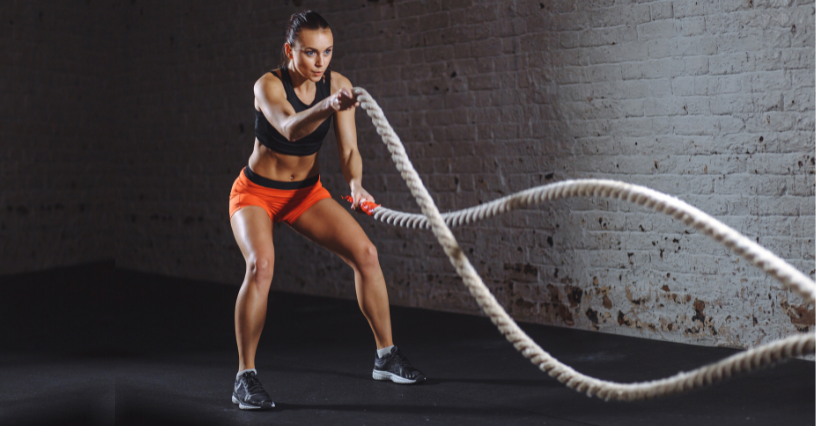Tabata is a 4 minute, very high intensity workout that improves aerobic and anaerobic capacity. It also accelerates the rate of calorie burning for up to 48 hours after exercise, causing the so-called oxygen debt. What is Tabata and what exercises can be performed as part of it?
What is tabata? What does this type of training consist of?
Tabata is a form of High Intensity Interval Training (HIIT) developed by Irisawa Koichi (coach of Japan’s national speed skating team) and Japanese teacher Izumi Tabata, after whom this training protocol is named .
In 1996, they conducted a study on two groups of Olympic athletes. One did an hour of cardio training five days a week.
In the other group, a training routine based on alternating periods of 20 seconds of extreme effort with periods of 10 seconds of rest was used. The entire activity consisted of eight rounds and lasted only four minutes. Both groups trained on a stationary bike.
Before the study, each participant’s aerobic (aerobic, work at 70% VO2max – an indicator of maximal oxygen uptake in 1 minute) and anaerobic (anaerobic, effort at 170% VO2max) capacity was measured. After 6 weeks of testing, it was found that the athletes who followed the 4-minute protocol increased their anaerobic capacity by an average of 28%, while the first group saw virtually no change.
They also performed better in terms of aerobic capacity. EPOC (Excess post-exercise oxygen consumption, measured in ml per kg of body weight per minute) increased by 7 ml of oxygen/kg, while the average result for the first group was 5 ml of oxygen/kg.
This means that the body used more energy to return to normal function after performing 4 minutes of exercise at an extremely high speed than for 60 minutes of moderate exercise.
A correct tabata involves performing an exercise in 4 minutes divided into 8 series – 20 seconds of work and 10 seconds of rest.
The exercise should be complete and involve as many muscle groups as possible, for example, squats, sit-ups, burpees (aka dips, pull-ups or push-up jumps), skip A (running in place with a high knee lift), mountain climbers, overhead dance floor kicks or push-ups.

Currently, fitness clubs offer a class called Tabata, which lasts 45-60 minutes and is more of a HIIT interval workout. In addition, to make the routine more interesting and varied, 2, 4 or 8 exercises are used per tabata, which is not quite what was originally intended. During a tabata, each set should be performed at maximum speed (approximately 95% HRmax).
Done properly, Professor Tabata’s routine should ensure that after 4 minutes of training, you won’t be able to do the same effort again. Exercises should be preceded by a warm-up and followed by stretching.
What are the effects of tabata training?
The main benefit of doing tabata is to increase the body’s aerobic and anaerobic capacity. During this training, anaerobic processes predominate, contributing to the so-called oxygen debt, which means that more oxygen is consumed than usual during rest, and this helps to speed up the metabolism and burn calories without additional effort. The result is a reduction in body fat and a slimmer figure. This form of exercise also improves:
- condition;
- muscular endurance and strength;
- immune system activity (higher immunity);
- cardiovascular system activity;
- lung capacity;
- resistance to acidification.
For tabata to provide adequate benefits, it is advisable to do it a maximum of 2-3 times a week, with a break to allow the body to recover from the extreme training.
For whom will tabata be suitable?
Tabata is an exercise system suitable for any trained person who wants to quickly and effectively improve their physical condition.

For those who are new to physical activity, it is a good idea to start by perfecting a correct exercise technique and an effort aimed at improving general physical condition. If an untrained person undertakes an actual tabata, it may result in nausea or even fainting.
Tabata is not recommended for people who have, among others: poor physical condition, high blood pressure, respiratory and cardiovascular diseases, overweight or obesity, heart conditions or defects. If you are not sure if this form of training is right for you, ask your doctor.
Tabata training: trial exercise plan
In keeping with tabata, focus on multi-joint exercises that involve large muscle groups. In addition to the exercises mentioned above, as part of tabata you can perform:
- box;
- power jacks;
- jumps;
- pumping in different versions: with the hand from the floor, on one hand, in a diamond, etc..;
- jump to get up from your knees;
- sprints;
- in and out squat (squat jumps from a narrow to a wide leg position and back);
- squat jump;
- devil press (a combination of burpees and dumbbell presses on the return);
- burpee shuttle run.

Tabata for beginners should be done under the guidance of a personal trainer, who will adapt the exercises to your physical condition, ensure that you develop the correct technique and maintain a pace suitable for the student’s ability.
You can also prepare for a proper tabata on your own, starting with regular cardio workouts. Start with exercises where you alternate periods of moderate intensity with periods of rest in a ratio of 1:3.
As your fitness and endurance improve, increase your exercise time and shorten your rest time. For example, you can combine 1 minute of jogging on a treadmill with 3 minutes of brisk walking, or 2 minutes of moderate cycling with 6 minutes of steady pedaling.
How many calories are burned during a tabata?
According to research, a 4-minute tabata is about 60 kcal less, that is, one minute allows you to burn about 15 kcal. Including the warm-up and stretching exercises, you will burn between 250 and 300 kcal in 15-18 minutes.
The final result depends on individual parameters such as gender, age, height, weight, training level and exercise intensity.
Also remember that the high burn lasts up to 48 hours after training, which, according to research, allows you to lose between 150 and even 450 kcal without effort.
Useful equipment and accessories for tabata training
Tabata can be performed not only with your own body weight, but also with additional equipment, such as:
dumbbells, kettlebells, dumbbells, battle rope, box, barbell, medicine ball (slam ball, wall ball or skipping rope. O good way to do tabata is to use cardio equipment such as: stationary bike, rowing machine, air bike (air bike) or treadmill.

Examples of tabata exercises with equipment:
- Pull-ups on a bar;
- jumps;
- thruster (squatting with kettlebell weights or dumbbells pushed overhead);
- rowing on a rowing machine;
- riding a stationary bike;
- air cycles;
- Box Jump;
- kettle swings;
- hoops with ropes;
- WallBall kick (throwing a medicine ball from a crouched position at, for example, a wall);
- pushing a sled.
Remember that tabata will produce the desired results if you follow the original protocol of this form of exercise.



